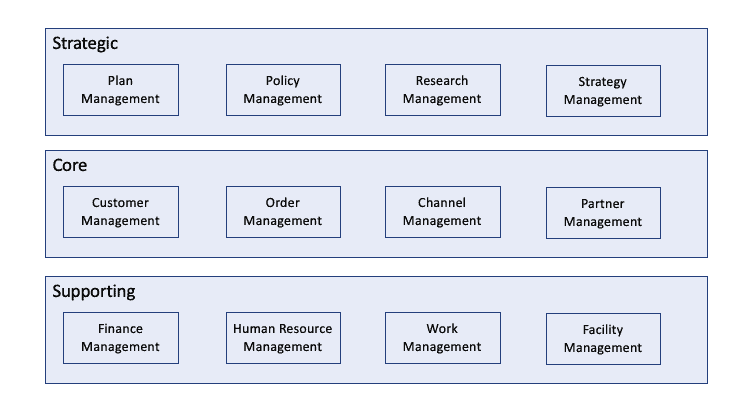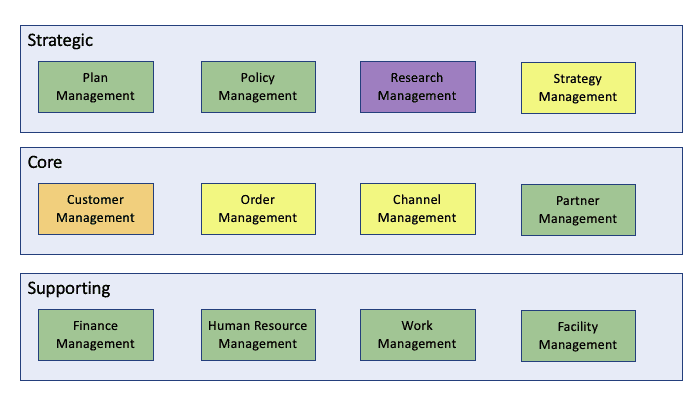Do you ever feel like your business could be doing better if only you knew what your capabilities were? A business capability map can help you figure that out. Once you have created a capability map it can be used to identify areas where your business could improve its performance.
Table of Contents
Introduction to Business Capability Mapping
What is a Business Capability?
The BIZBOK guides
As defining what a business does to achieve a purpose or outcome.
Business capabilities are fundamental building blocks of a company and may be used to improve, rearrange, and implement different or more effective ways to achieve corporate goals.
Business capabilities describe what a company is doing presently and what it must do to confront present and future challenges.
The objective of having business capabilities is so that we can have a common ground to discuss and plan. By focusing on what a business does, management and project teams can easily understand and break down the different aspects of the business.
Business capability modelling is a method of representing what an organisation does, independent of its structure, processes, people or domains.
What is a Business Capability Map?
A business capability map is a succinct business-centric view of the company at its most basic level, and it covers all elements of what the organisation does. A business capability map is a blueprint or visual artefact that is used to show a collection of business capabilities.
Capability mapping can be used to better align business and technology and provides a view and a common language of the organisation that both business and technology can understand. The capability map describes the capabilities needed to operate and execute on strategy.
Common Approach for Representing Business Capabilities
One way to represent business capabilities is by creating a series of boxes at different levels. For example, one capability (i.e., box) can be decomposed into subsequent levels depicting capabilities that are accessible to the context and people of the organisation referencing the business capability map.
Understanding how capabilities fit within an organisation is made easier by deconstructing the business capabilities, which is an abstraction of what a company does.

Capability Instance
A business capability may exist in multiple business units and enable multiple value streams and value stream stages.
As a result, the phrase “business instance” has emerged, which is defined in the BIZBOK manuals as
A particular realisation of a capability as it exists or is foreseen to exist in the context of a given business unit or another situational context.
Benefits of using Business Capabilities and Capability Mapping
The advantages of employing business capabilities are as follows:
- Easy to understand, use and practice.
- Easily understood by business and technology.
- It is static and rarely changes (compared to business processes).
- Provides a common business vocabulary that facilitates a company’s ability to quickly assess problems and develop solutions.
- Can be used to identify duplicate or inefficient processes.
- Provides a foundation for strategic planning and helps identify enterprise-wide impacts.
- By understanding what is normal for a business, management can discern which divisions function similarly or differently and take necessary steps to improve areas of weakness.
- Can be used to influence and identify silos to aid in restructuring.
- Informs business investment decisions – identifying which capabilities are needed to support the organisation.
How to do Business Capability Mapping
The capability map is a standard business blueprint that depicts a company’s capabilities.
There are no clear guidelines on how to do capability mapping – but there are a few methods.
The top-down enterprise approach creates a solitary map for the entire business.
It is not unlikely for a business unit to develop its capability map that only encompasses the capabilities of that particular unit.
Capability Levelling
Capabilities can be described in more depth by breaking them down into multiple levels. This is a standard way of depicting a capability, and it allows for further decomposition where necessary. The original work on business capabilities established a three-level structure, as follows:
- Foundation capability – level 1
- Capability group – level 2
- Business capability – level 3
In practice, capability decomposition is frequently extended beyond level 3 or 4, with many individuals abandoning the naming conventions in favour of decomposition level numbers.
When breaking down a capability, it should be based on a single business object.
Capability Map Stratification
It is useful for presentation for a capability map to be divided into three categories for planning and analysis purposes, as follows:
- Strategic or direction setting – capabilities that provide direction.
- Core, customer-facing – goes to the heart of what a business does to ensure viability and thrive in the marketplace.
- Supporting – represent abilities that an organisation must have to function as a business.

Organising the Capability Mapping Team
Who does capability mapping and to the extent that capability mapping is performed will depend upon the organisation’s context and what basis capability mapping is being performed.
The following roles are important to an effective business capability mapping team:
- Business sponsor – it is difficult to build a capability map without senior business sponsorship.
- Business lead – should be led by a business lead or a practitioner of business architecture with deep business knowledge.
- Subject matter experts – a core set of representatives with knowledge of all major aspects of the business.
Capability Mapping Guidelines
The following guide will assist teams with identifying and delineating capabilities.
- Consider what a capability is in terms of outcomes.
- Ensure that capabilities are unique in terms of intent.
- A capability should exist once only in the organisation
- Do not overgeneralise the business.
- Use language and terminology that is appropriate and understood by the business.
- Ignore the 80/20 rule – if an SME
states that we rarely have to do that – still define it.
- Your business’ highest-level capabilities should be a complete description of what your business does. Consider making your categories reflect key aspects of the day-to-day workings to give an accurate portrayal.
- You’ll know you have good, non-overlapping capabilities when you can assign Level 2 capabilities without any confusion.
- A capability is expressed as a noun (e.g. customer management)- compared to a process that is expressed as a verb (manage customer).
- Well-defined business capabilities don’t change much over time, regardless of any shifts in the organisation. The only exception to this rule is if there is a substantial update made to the organisation’s strategy.
- Avoid using the word capabilities at any level of the capability name.
- Focus on business objects – objects provide a capability focal point.
- Don’t stress too much about business units. The capabilities should stay the same and operate independently of the organization’s current structure.
- If you go too deep, the audience will be overwhelmed by all the information. Maintain a three-level distance between yourself and your readers to demonstrate your organization’s breadth of capabilities. This will enough for your company’s IT landscape.
- When developing your map, including those who define the strategies. When defining your company’s capabilities at the top level, consider strategy as one factor.
Leveraging Industry Capability Reference Models
You can use reference models
Leveraging Capability Mapping Templates
Teams require a basis to record and manage capabilities as the analysis progresses.
A standard business capability map template for excel is as follows:
- Tier – equates to the strategic, core or customer-facing and supporting tiers
- Level – capability level – e.g. level 1
- Capability – the name of the capability.
- Definition – definition of the capability.
- Outcome – what is expected to be achieved by the capability.
- Heat map rating – if the capabilities are being rated or compared.
- Impact rating – if the capabilities are being used to assess impact on the organisation.
Business Capability Mapping Tools
Various tools can be used for doing business capability maps.
You can start with Visio or PowerPoint before moving to architectural tools.
Some free capability mapping tools include:
Capability Map – How to Create a Heat Map
Heat mapping is an extension of the basic capability mapping effort because it involves another level of analysis.
The BIZBOK guide
- Red- significantly problematic.
- Orange – problematic – not severe.
- Yellow – suboptimal.
- Green – working well.
- Purple (or another colour) = does not exist but should.
- No colour – not evaluated.

Packaging and Publishing the Capability Map
Here are some useful approaches to packaging and publishing the capability map.
- Create a single-page level 1 map for executive-level discussions.
- Create a single page level 1-2 map for planning discussions.
Delivering a pictorial – is a fast way to communicate what a business does.
Capabilities Relate to Other Aspects of a Business
A business capability is a company’s ability to produce goods or provide services and is related to the following concepts:
- Information – capabilities requires and modify the information.
- Organisation – business units have capabilities.
- Strategy, policy, product, initiative – capabilities are impacted by strategy, policy, business initiatives and enable products.
- Value streams – capabilities enable value stream stages.
Business capabilities should represent actual business things and describe the activities that are performed against them. The set of business capabilities should provide the tools and resources necessary to run a company.
A Capability Driven Business-to-Technology Roadmap
A business-to-technology roadmap based upon capabilities can be developed in 6 stages:
- Map capabilities – capabilities of the organisation are identified and broken down or refined to describe lower capabilities of various levels ideally up to a level of 3 or 4.
- Rate capabilities – current capabilities are rated on how they are meeting the organisation’s strategy.
- Identify capability uplifts – this may determine new capabilities based upon a change of strategy or capabilities that perhaps may no longer be needed and helps shape the future view.
- Prioritise capabilities- capabilities are prioritised (high, medium, low) based on the organisation’s strategy based.
- Create a business roadmap – a business roadmap is created based on the capabilities.
- Create a technology roadmap -the technology roadmap is aligned to the business roadmap.

